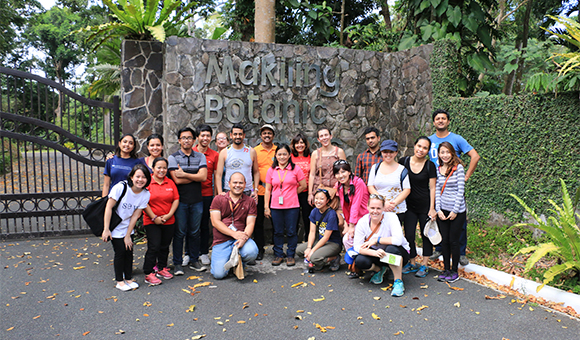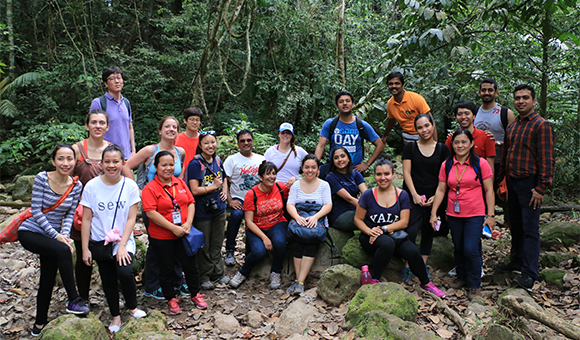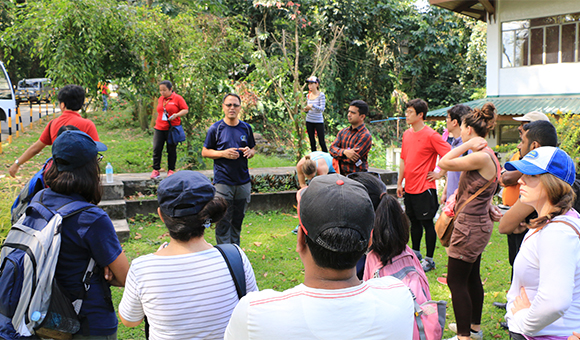Asian Institute of Management Philippines
The third day of the course comprised a one-day classroom session at Milea Bee Farm, in Lipa, Batangas, and at Patis Tito Garden Cafe at San Pablo, Laguna. Sustainable agriculture and business models utilized in both sites were showcased in these two sets of lectures. The first half of the day was spent at Milea Bee Farm, where the students were given a lecture by the bee farm owner himself, Rico Omoyon. He started by giving an introduction on Philippine bees, emphasizing the abundance of bees in the country where a total of six types of species can be found. "Philippines is an agricultural country, yet we don't value agricultural beekeeping," said Omoyon. Bees are treated as pests. Their value as pollinators responsible for greater yield of plants and fruits are neglected. As an advocate of proper beekeeping and breeding, he talked about his experiences in teaching beekeeping to schools around the country as well as in remote islands, stating "although bee keeping enthusiasts like me are small in number, we will continue sharing what we know," says Omoyon.

Omoyon continued his lecture on sustainable beekeeping and agriculture practices while giving the students a tour around his farm. He showcased the use of recycled materials as agricultural and beekeeping tools, such as using discarded plastic containers as planters for seedlings, old rice cookers as artificial bee hives, etc. By the end of the visit, students learned about beekeeping and its significant value in maintaining the diversity and proliferation of agriculture and ornamental plants.
The afternoon session was spent at Patis Tito Garden Cafe. Beatriz “Patis” Tesoro Pamintuan, the owner of Patis Tito Garden Café and the "Grand Dame of Philippine Fashion," provided a lecture on the business model she follows in her sustainable fashion designing. "Revival of the Piña cloth," she calls it. She shared her knowledge on the production processes involved in the making of the cloth, emphasizing the intricacies and the strict use of manual labor employed in cloth making. She believes that through the use of these materials her fashion designs holistically represent the culture and heritage of the Philippines.

Furthermore, she said that "people have to put more value in hand-made products." The business of using Piña and other Philippine indigenous materials in fashion designing requires the involvement of the local community. The work of a designer does not start and end in the designing process; instead, the designer should be able to work with the individuals behind the cloths they use, immersing themselves to the details of cloth-making. It is by understanding how these cloths are made that designers can put more value to the final product. By the end of her lecture, Pamintuan showcased her fashion pieces, describing the process involved in making them. Her designs are not just clothes; they are symbolic of "cultural and societal stature."
From the discussions on the third day, it has been made clear that successful business models both in the agriculture and fashion industry entails the realization of the significance of using sustainable resources and materials in one's business ventures.
The fourth day of the course was spent at the Makiling Center for Mountain Ecosystems at the University of the Philippines – Los Banos. Nathaniel Bantayan, director of Makiling Center for Mountain Ecosystems, delivered an introduction on the history and significance of Mount Makiling in the practice of sustainable forestry and ecosystem. Apart from the presence of a very diverse number of trees species, Philippines is known to be one of the countries with rich geothermal energy plants, two of which are found in Mount Makiling. “With good forest, everything is okay,” said Bantayan, explaining the value of maintaining rich and abundant forests in the country. He believes that by involving the local communities and the youth on sustainable forestry can the forests all over the country thrive and continue to flourish. “We involve students and the members of the local community to contribute in this venture of nature tourism,” said Bantayan.

The hike to Mt. Makiling commenced after the short introduction. The students were set to visit two sites in the mountain, namely, the flat rocks, and the mud spring. The site where flat rocks are found were first to be visited. The flat rocks, a dry riverbed, serve as one of the main attractions of ecotourism in the mountain. Next to be visited was the mud spring, one of the features of geothermal energy in Mount Makiling. According to the tour guide, mud spring is considered as a sleeping volcano given its high temperature and acidity level. For the rest of the trail, the students were introduced to the variety of trees and plants species found in the mountain.
A visit to the Binhi Biodiversity Park, which contains a collection of specimens of the trees species found all over the Philippines, followed. The students were accompanied by Dr. Rogelio Andrada II, deputy director of Makiling Center for Mountain Ecosystems. Andrada described the park as a gene bank of the various trees species in the country. The students were able to explore the park while learning about the distinct features of each of the trees species. “We want to foster sustainable forestry by housing the thriving and the endangered tree species in the country,” said Andrada.
The Makiling Botanic Gardens was the final site visited by the students. The gardens served as the haven for the flaura and fauna at Mount Makiling, contributing to the mountain’s ecotourism. Andrada provided a lecture to the students through a tour at the gardens, discussing the characteristics of each plant found in the garden.
The value of sustainable forestry and ecotourism was realized by the end of the fourth day. The students were able to assess how the number of trees in the forest, as well as the number of tourists visiting the mountain affects the not only the local community living within the vicinity of the mountain, but also the larger ecosystem of the country.
